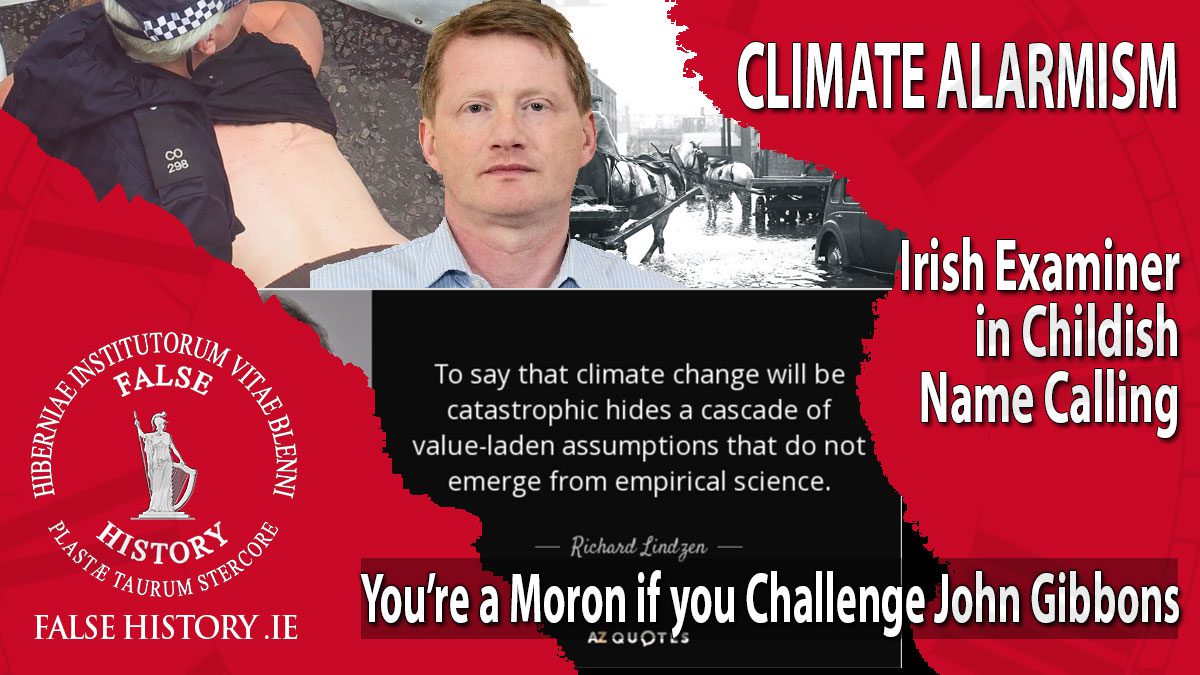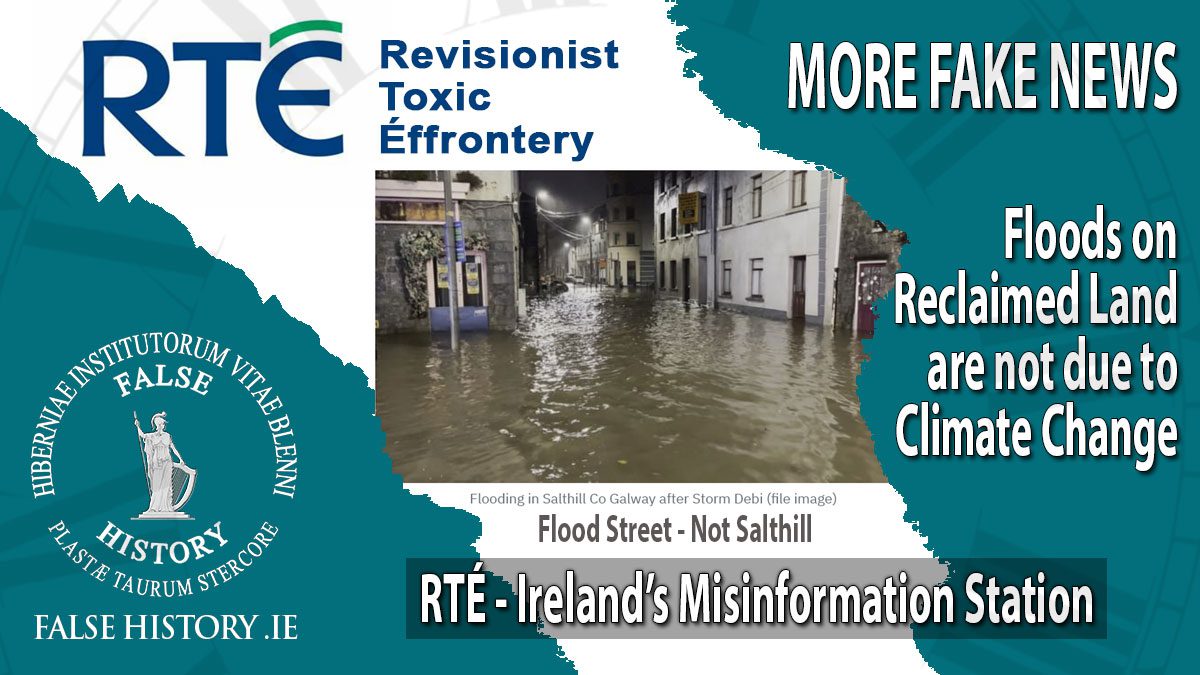Climate change activism often involves individuals with a simplistic view of the world and a limited grasp of scientific principles. John Gibbons, an environmental journalist and commentator, serves as a notable illustration of this phenomenon through his behaviour on social media.
Recently, Mr. Gibbons penned an article for the Irish Examiner in response to the flooding events in Cork. The piece was accompanied by a photo capturing residents of Glanmire discarding flood-damaged furniture into a skip. This incident highlights not only the challenges faced by the community, but also the need for a more informed and nuanced discussion surrounding climate change.
Gibbons wasn’t the sole advocate leveraging the floods in Cork to advance a particular agenda. Social media saw a surge of individuals, spanning from Green politicians to climate alarmists, eager to portray the floods as conclusive evidence of climate change.
It’s worth noting that the name “Cork” is a deviation from the Irish term “Corcaigh,” meaning a marsh or swamp. This etymology underscores that the ancient city of Cork is situated in a swamp, standing at the river Lee’s lowest crossing point in the tidal region. Historical records reveal that Cork has faced recurrent flooding throughout the centuries, primarily due to its geographical placement. Consequently, the floods in Cork city cannot be attributed to climate change. Similarly, floods in other parts of Cork County stem from the positioning of towns and structures on floodplains. Take Middleton, for instance, where floods are entirely artificial, resulting from poor location choices, inadequate planning, subpar engineering, and impractical expectations.
Globally, substandard engineering ranks amongst the leading causes of urban flooding. Instances like the floods at the Dundrum Shopping Centre and Letterkenny Hospital underscore this point. In Dundrum, a seemingly inconspicuous stream was redirected into pipes, disregarding the fact that it had originally traversed a deep valley. When the stream swelled, it went unnoticed.
Engineers are tasked with sizing pipes based on the “once in one hundred years event” principle, or 0.1%. Simply put, the pipes should accommodate the most significant flow of water without obstruction. However, in practice, these calculations often rely on assumptions. In the case of the Dundrum Shopping Centre, shortly after its opening, heavy rain hit the Dublin mountains. The stream, following its natural course, swelled as usual. Unfortunately, the pipes, sized based on a mere guess, proved too small, leading to flooding.
A similar miscalculation occurred in Letterkenny, where the underestimated size of a culvert beneath a main road resulted in flooding at the hospital. Situated on the site of an ancient dam and corn mills, prone to flooding for centuries, the Letterkenny hospital experienced substantial damage in a 2013 flood, followed by a minor one a year later. The hospital’s bowl-like location at the bottom of a steep hill exacerbates its vulnerability to heavy rain.
Middleton in County Cork, located on a sea inlet with rivers to the west and south, has a history of flooding, especially after heavy rain. The name Owenacurra river is a transliteration of Abhain na Curragh meaning the river of the marsh. More ancient evidence that the town is situated in a swamp. Yet, amidst these events, no climate commentator highlighted the historical susceptibility of these areas to flooding, attributing the incidents solely to climate change. Meanwhile, some journalists resorted to sensationalism, prioritising emotional impact over factual reporting.
Nature, it seems, defies engineers. The belief that engineering can outsmart nature often clashes with reality. Examples include the overtopped tsunami wall in Ryoishi, Japan, and the 2012 flooding in St Asaph, Wales, due to breached flood defences, underscore the limitations of engineering based on false assumptions.
The most practical solutions, such as relocating settlements from floodplains or restoring floodplains to reduce flood severity, are often overlooked. These sensible approaches contrast with the antics of climate activists, as highlighted by the New York Post’s characterisation of them as “, ‘Climate activists? Ha! More like full-grown children seeking attention’.” Even in online interactions, like John Gibbons’ response to a tweet, a lack of professional decorum undermines constructive discourse.
The consequence of widespread fear often leads to regressive behaviour, ill-thought protests, and the perpetuation of baseless scare stories. The public, hungry for sensational narratives, becomes unwittingly misled by media seeking clicks. In the realm of science, the prevalence of researcher bias, where contradictory evidence is ignored, remains a significant challenge, hindering the objective evaluation of theories.
Climate change alarmism often stems from individuals lacking a comprehensive understanding of science, leading them to rely on others for their opinions. This reliance fosters a cycle where these individuals, unable to substantiate their views with evidence, resort to immature name-calling—labelling dissenters as climate deniers or morons.
In a realisation of his own imprudence, Gibbons eventually deleted his responses and pre-emptively blocked any further comments from me, all captured in incriminating screenshots.
Despite adopting the username @think_or_swim, his actions suggest a deficiency in critical thinking and a penchant for scaremongering. It appears inevitable that he will soon find himself swimming in the submerged streets of Cork. The same streets that were once canals, now filled-in by human intervention, but reclaimed by nature at her discretion. This serves as a poignant reminder of human folly that nature persistently exposes.



Featured image montage. Photo of a climate protestor who glued her breasts to the street. John Gibbons. Flooding in Cork City in 1959. A quote from Richard Lindzen, a Harvard-educated American atmospheric physicist who has published more than 200 scientific papers and books.
EJ
Some References…
Gibbon’s article in Irish Examiner
Flood-hit hospital was built on site of ancient dam
Anger as floods hit hospital a year after €40m catastrophe
Welsh river spills over flood defences
Shocking footage of extreme flooding across Cork as experts warn ‘it will get worse’
Climate activists? Ha! More like full-grown children seeking attention



